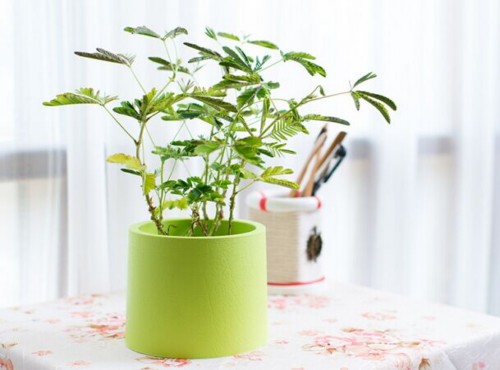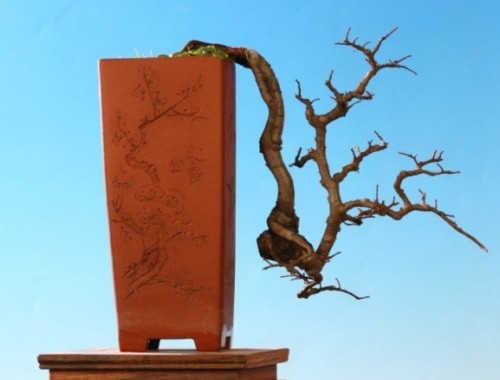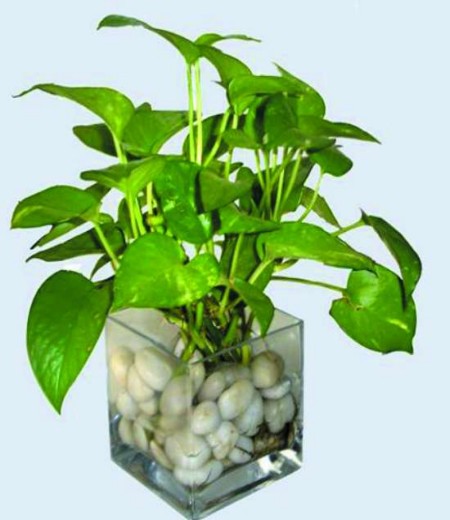Pay attention to the use of pots for bonsai
In bonsai art, it serves to deepen the theme, and the use of pots is an important knowledge. The proper use of the basin can not only echo the theme expressed by the bonsai, but also achieve a reasonable combination of plants and pots, show a higher artistic level, and depict a better picture effect.

According to its texture, bonsai basin can be divided into ceramic basin, porcelain basin, natural stone basin, glaze basin, plain burning basin, copper basin, wood basin, plastic basin and so on. From the perspective of ornamental and practical value, purple sand pottery basin is the best choice, purple sand is divided into cinnabar, cinnabar mud, purple mud, white mud, yellow mud, green mud, old mud and other kinds of mud, purple sand basin elegant and simple, strong air permeability and drainage performance, suitable for the planting of ancient trees and old piles; porcelain basin is smooth and beautiful, but the permeability is poor, it is suitable to be used as a set of flower and fruit bonsai; stone basin is suitable for making jungle type, drought type, miniature landscape bonsai and so on. Plastic pots and other bright colors, cheap, but poor permeability, easy to aging, only suitable for phased use in the training process, or as a set of pots, not suitable for exhibition or cultivation.
According to the morphological classification of the basin, it can be divided into rectangular basin, square basin, round basin, oval basin, octagonal basin, hexagonal basin, shallow mouth basin, flat basin, shield basin, crabapple basin, natural stone basin, natural bamboo basin and so on. In the color of the basin, it is generally better to be elegant and simple. Bonsai with flowers and fruits can be slightly brightly colored, but it must be coordinated with the color of flowers and fruits. Bonsai pots with landscapes should not be selected with the same color as mountains and rocks.
The basin is not only a container of scenery, but also a work of art with ornamental value. in order to make the bonsai picture beautiful, it is necessary to choose a good basin. The selection of the basin should be considered from the two aspects of the basin and the plant at the same time. The style, size, depth and color of the basin must be compatible with the shape and size of the plant. If the basin is big and the pile is small, the basin is empty, the stump scene is thin and weak, the small pile is large, and it appears to be too bloated, top-heavy, out of proportion, and disadvantageous to growth. Therefore, both beautiful and practical, simply pursue the beauty of the basin, often pile, basin do not adapt, and the growth of bonsai will also bring great harm. However, if you only consider practicality, pay one-sided attention to firmness and depth, and ignore its bulky and vulgar side, it will make the coordination of the basin and the scene irrelevant, and reduce the color of the picture; of course, you can also find the ideal basin first, and then choose suitable plants, or even partially transform the tree stump, so that the two can adapt to each other. Therefore, the layout of bonsai must seek the mutual adaptation and cooperation of pots and stakes, and the beauty of the shape and natural form of tree stumps can not be separated from the foil of pots and echo each other, so as to make it an inseparable and unified artistic whole.
Generally speaking, the proportion of the basin and the scene should be appropriate, the color should be coordinated, the shape should be commensurate, and the selection of the basin should vary according to the shape and plant species: for example, the pot for the big tree stump must be large and deep, and the square basin should be angular and dignified; the miniature bonsai should be small and exquisite. Landscape bonsai and other applications of shallow rectangular workers oval and light-colored porcelain, stone, cement, glass basins, etc., in order to fully show the landscape of "vast smoke waves, vast clouds and waves"; planting alone to enjoy the bonsai should be a relatively larger basin; cliff type suitable for the use of sign basin, can show the spirit of "steep waterfall, hanging upside down in the air"; oblique dry type, curved dry type bonsai is suitable for square basin, cylindrical basin, arc basin and so on Cutting and sowing can be done in wooden pots. In the process of selecting the basin, how to make the shape factors and inner meaning match vividly, complement each other, just right, and achieve a higher artistic realm remains to be explored, summarized and improved in practice.
Time: 2019-05-23 Click:
- Prev

The complexity of four-dimensional Space in Bonsai Art creation
People know that bonsai is a three-dimensional space art with length, width, height and depth, which is known as three-dimensional painting. It is not enough to master three-dimensional three-dimensional space in bonsai art creation, because any object (a wood or stone) is a three-dimensional three-dimensional space.
- Next

Advantages of bonsai soilless cultivation technique
Bonsai soilless cultivation is a cultivation method in which bonsai plants are planted in some inorganic substrates and regularly irrigated with nutrient solution. Compared with traditional soil cultivation, bonsai soilless cultivation has many advantages and will become an important symbol of the modernization of bonsai production.
Related
- Fuxing push coffee new agricultural production and marketing class: lack of small-scale processing plants
- Jujube rice field leisure farm deep ploughing Yilan for five years to create a space for organic food and play
- Nongyu Farm-A trial of organic papaya for brave women with advanced technology
- Four points for attention in the prevention and control of diseases and insect pests of edible fungi
- How to add nutrient solution to Edible Fungi
- Is there any good way to control edible fungus mites?
- Open Inoculation Technology of Edible Fungi
- Is there any clever way to use fertilizer for edible fungus in winter?
- What agents are used to kill the pathogens of edible fungi in the mushroom shed?
- Rapid drying of Edible Fungi

